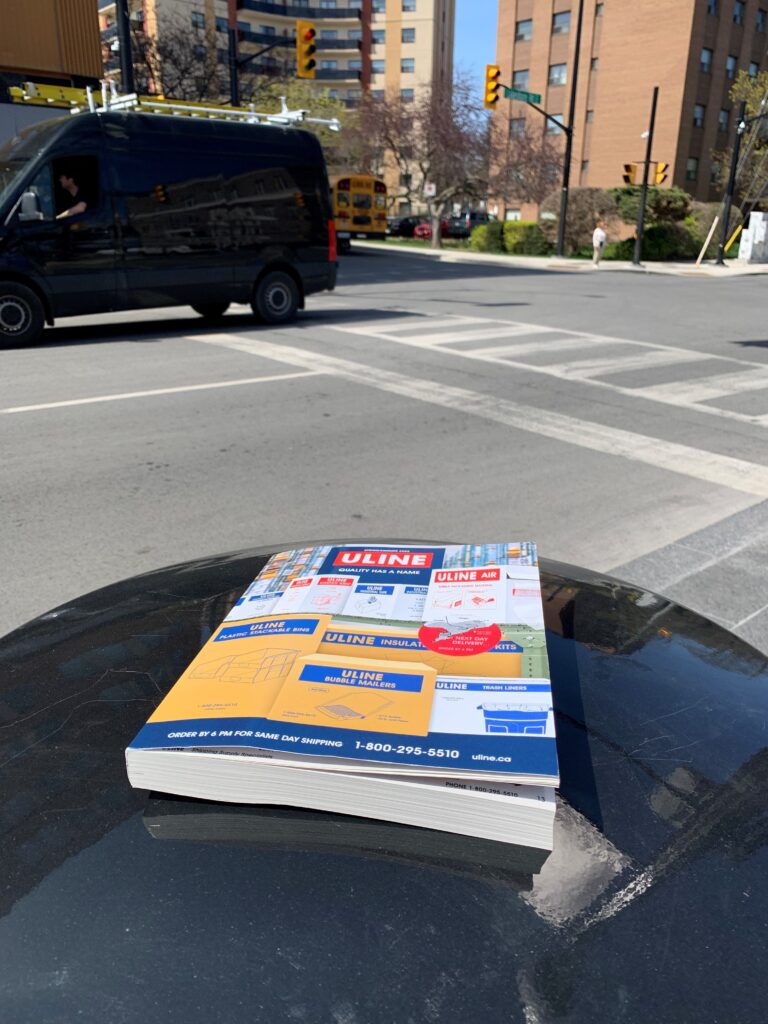
Features
Chronicle
Opinion
Uline’s challenge to naysayers
A printed catalogue places Uline in the hands of prospective customers in an unassuming way
August 19, 2022 By Nick Howard
 A printed catalogue places Uline product list directly in the hands of employees who may find something new and valuable to order. Photo courtesy Nick Howard
A printed catalogue places Uline product list directly in the hands of employees who may find something new and valuable to order. Photo courtesy Nick Howard Recently, Uline, a privately owned supplier of everything from trash bags to bakery boxes, included in their delivery package an 800-page catalogue. I was intrigued. Why was Uline, a savvy and successful business, embracing an archaic marketing tactic: the printed catalogue?
However, Uline isn’t the only business mailing catalogues to customers. W.W. Grainger, Inc., another well-known industrial supplier, has the largest ‘mailed’ catalogue I’ve ever received. Coming in at over 3,200 pages, it would be an understatement to call it ‘massive’. Several other distributors have also continued swimming against the online current to distribute meaty volumes. All these companies (and many more) can’t be that slow or lack intelligence. Wasn’t print dying? Didn’t they get the memo?
I reached out to Brian Shenker in Pleasant Prairie, Wis., Uline’s vice-president of direct marketing and advertising, to find out why Uline was sticking to a medium many of us have given up for dead. We discussed Uline’s marketing (print editions, mailers, cards, social media, and direct email) strategies. Shenker said Uline wishes to control the complete advertising cycle, and print plays an important role in making the company more noticeable to prospective customers.
He went on to say that a printed catalogue can place Uline products directly into the hands of, for instance, a warehouse employee who initiated the order, but wasn’t named on the purchase order. The catalogue has a way of cutting through rigid company structures and showing up in a shipping office or company cafeteria or even taken home by an employee. The catalogue lingers, well past its expiry date. Remember the old Sports Illustrated issues in your hairdresser’s salon.
Shenker acknowledged that current paper shortages are a major concern and Uline must be flexible in choosing the paper and weight for individual runs. Regardless of the current crisis, Shenker believes a printed catalogue does an excellent job in circumventing the traditional purchasing agent while reaching a wider body of potential buyers at the same location. When the goods arrive—with a requisite free-ride catalogue in tow—the ultimate user often discovers valuable items they didn’t know about.
Large expenditures to keep mailing lists up to date are necessary, and Shenker believes the expense and time are well worth the trouble. Ironically, the mailing list serves both print and online activities. Various printed catalogues can reach specific customers in restaurants, offices, and warehouses.
According to Shenker, Uline’s printed catalogues are getting positive reviews from customers. He believes Uline’s catalogues are in the spotlight because considerably less catalogues are direct mailed today. Shenker was adamant in suggesting that some of his competitors exited print early and are now regretting their hasty decisions.
Shenker believes print campaigns can increase Uline’s sales but worries about the declining amount of web printers who can serve his needs. The decline in commercial web plants (large enough to handle his work), growing materials shortages, and rising prices keep him on his toes. Recently in the United Kingdom, YM Group’s massive implosion is just the latest in a trail of web firms that ran out of road.
Surprisingly, Shenker had nothing but praise for the US Postal Service, referring to them as “still a bargain.” He had fewer plaudits for Canada Post, who are “more expensive”. Catalogue distribution is not specific to the mails either. Uline takes full advantage of the thousands of packages leaving their warehouses each week to insert printed materials or special editions to specific users.
This column originally appeared in the July/August 2022 issue of PrintAction.
Print this page